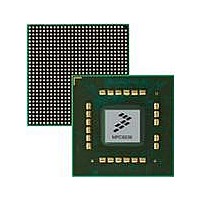MPC8536DS Freescale Semiconductor, MPC8536DS Datasheet - Page 1586

MPC8536DS
Manufacturer Part Number
MPC8536DS
Description
BOARD DEV SYSTEM MPC8536E
Manufacturer
Freescale Semiconductor
Series
PowerQUICC III™r
Type
MPUr
Datasheets
1.MPC8536EBVTAVLA.pdf
(127 pages)
2.MPC8536EBVTAVLA.pdf
(1706 pages)
3.MPC8536DS.pdf
(2 pages)
4.MPC8536DS.pdf
(126 pages)
Specifications of MPC8536DS
Contents
Board, Software and Documentation
Processor Series
MPC85xx
Core
e500
Data Bus Width
32 bit
Maximum Clock Frequency
667 MHz
Operating Supply Voltage
- 0.3 V to + 1.21 V
Maximum Operating Temperature
+ 105 C
Data Ram Size
32 KB
Interface Type
SPI, USB
Program Memory Type
DDR2, DDR3, SDRAM
Core Size
32 Bit
Program Memory Size
544KB
Cpu Speed
1.5GHz
Digital Ic Case Style
BGA
No. Of Pins
783
Supply Voltage Range
0.95V To 1.05V
Rohs Compliant
Yes
For Use With/related Products
MPC8536
Lead Free Status / RoHS Status
Lead free / RoHS Compliant
- MPC8536EBVTAVLA PDF datasheet
- MPC8536EBVTAVLA PDF datasheet #2
- MPC8536DS PDF datasheet #3
- MPC8536DS PDF datasheet #4
- Current page: 1586 of 1706
- Download datasheet (15Mb)
Debug Features and Watchpoint Facility
25.1.3.1
The LBC and the DDR SDRAM controller can drive debug information (source ID and data-valid
indicator) onto MSRCID[0:4] and MDVAL. As shown in
controls multiplexing. If MSRCID0 is low when sampled during POR, the local bus SDRAM information
appears on MSRCID[0:4] and MDVAL; otherwise, the DDR SDRAM debug information is presented.
25.1.3.2
MSRCID1 is sampled during POR to multiplex either ECC or debug information on the ECC pins of the
DDR SDRAM interface. As shown in
in debug mode and provide memory debug source ID and data-valid information. MSRCID1 must be
pulled low during POR to use the ECC pins in debug mode. If MSRCID1 is unconnected, an internal
pull-up resistor ensures the ECC pins always source DDR SDRAM error correcting code information as
their default power-on reset configuration.
25.1.3.3
The watchpoint monitor supports the following operating modes:
25.1.3.4
The trace buffer supports the following operating modes:
25-4
•
•
•
•
•
•
Immediate trigger arming (one-level triggering)—The watchpoint monitor triggers as soon as the
first trigger event occurs.
Wait for trigger arming (two-level triggering)—The watchpoint monitor waits for a specific event
before enabling (arming) the trigger logic. The monitor does not respond to trigger events until
after the arming event occurs. This function is similar to two-level triggering on a logic analyzer.
Assert TRIG_OUT on hit—The debug block can be programmed to assert the TRIG_OUT signal
when a programmed watchpoint monitor event occurs. This signal can be used to trigger a logic
analyzer.
Immediate trigger arming (one-level triggering)—The trace buffer triggers as soon as the first
trigger event occurs.
Wait for trigger arming (two-level triggering)—The trace buffer waits for a specific event before
enabling (arming) the trigger logic. The trace buffer does not respond to trigger events until after
the arming event occurs. This function is similar to two-level triggering on a logic analyzer.
Specific interface selection—The trace buffer can be programmed to trace one of several internal
interfaces.
Local Bus (LBC) Debug Mode
DDR SDRAM Interface Debug Modes
Watchpoint Monitor Modes
Trace Buffer Modes
If the DDR ECC pins are in debug mode (configured for debug during
POR), ECC checking is disabled in the memory controller. In this case,
MECC[0:4] do not provide ECC information and must not be connected to
SDRAM devices.
MPC8536E PowerQUICC III Integrated Processor Reference Manual, Rev. 1
Table
25-1, if MSRCID1 is low during POR, the ECC pins operate
NOTE
Table
25-1, the MSRCID0 value during POR
Freescale Semiconductor
Related parts for MPC8536DS
Image
Part Number
Description
Manufacturer
Datasheet
Request
R
Part Number:
Description:
Manufacturer:
Freescale Semiconductor, Inc
Datasheet:
Part Number:
Description:
Manufacturer:
Freescale Semiconductor, Inc
Datasheet:
Part Number:
Description:
Manufacturer:
Freescale Semiconductor, Inc
Datasheet:
Part Number:
Description:
Manufacturer:
Freescale Semiconductor, Inc
Datasheet:
Part Number:
Description:
Manufacturer:
Freescale Semiconductor, Inc
Datasheet:
Part Number:
Description:
Manufacturer:
Freescale Semiconductor, Inc
Datasheet:
Part Number:
Description:
Manufacturer:
Freescale Semiconductor, Inc
Datasheet:
Part Number:
Description:
Manufacturer:
Freescale Semiconductor, Inc
Datasheet:
Part Number:
Description:
Manufacturer:
Freescale Semiconductor, Inc
Datasheet:
Part Number:
Description:
Manufacturer:
Freescale Semiconductor, Inc
Datasheet:
Part Number:
Description:
Manufacturer:
Freescale Semiconductor, Inc
Datasheet:
Part Number:
Description:
Manufacturer:
Freescale Semiconductor, Inc
Datasheet:
Part Number:
Description:
Manufacturer:
Freescale Semiconductor, Inc
Datasheet:
Part Number:
Description:
Manufacturer:
Freescale Semiconductor, Inc
Datasheet:
Part Number:
Description:
Manufacturer:
Freescale Semiconductor, Inc
Datasheet:










